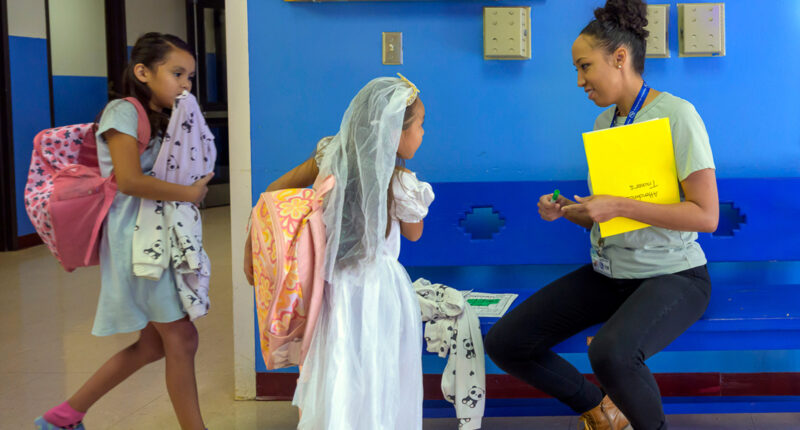After missing 40 days of school last year, Tommy Betom, 10, is on track this year for much better attendance. The importance of showing up has been stressed repeatedly at school – and at home.
When he went to school last year, he often came home saying the teacher was picking on him and other kids were making fun of his clothes. But Tommy’s grandmother Ethel Marie Betom, who became one of his caregivers after his parents split, said she told him to choose his friends carefully and to behave in class.

Attendance Clerk Katrice Grant speaks to siblings Melanie Pacheco, 8, left, and Marilynn Pacheco, 5, in the hallway before heading to their classrooms.
AP Photo/Roberto E. Rosales
He needs to go to school for the sake of his future, she told him.
“I didn’t have everything,” said Betom, an enrolled member of the San Carlos Apache tribe. Tommy attends school on the tribe’s reservation in southeastern Arizona. “You have everything. You have running water in the house, bathrooms and a running car.”
A teacher and a truancy officer also reached out to Tommy’s family to address his attendance. He was one of many. Across the San Carlos Unified School District, 76% of students were chronically absent during the 2022-2023 school year, meaning they missed 10% or more of the school year.
___
This story is part of a collaboration on chronic absenteeism among Native American students between The Associated Press and ICT, a news outlet that covers Indigenous issues.
____
Years after COVID-19 disrupted American schools, nearly every state is still struggling with attendance. But attendance has been worse for Native American students – a disparity that existed before the pandemic and has since grown, according to data collected by The Associated Press.
Out of 34 states with data available for the 2022-2023 school year, half had absenteeism rates for Native American and Alaska Native students that were at least 9 percentage points higher than the state average.
Many schools serving Native students have been working to strengthen connections with families, who often struggle with higher rates of illness and poverty. Schools also must navigate distrust dating back to the U.S. government’s campaign to break up Native American culture, language and identity by forcing children into abusive boarding schools.
History “may cause them to not see the investment in a public school education as a good use of their time,” said Dallas Pettigrew, director of Oklahoma University’s Center for Tribal Social Work and a member of the Cherokee Nation.
On-site health, trauma care helped bring students back
The San Carlos school system recently introduced care centers that partner with hospitals, dentists and food banks to provide services to students at multiple schools. The work is guided by cultural success coaches – school employees who help families address challenges that keep students from coming to school.
Nearly 100% of students in the district are Native and more than half of families have incomes below the federal poverty level. Many students come from homes that deal with alcoholism and drug abuse, Superintendent Deborah Dennison said.
Students miss school for reasons ranging from anxiety to unstable living conditions, said Jason Jones, a cultural success coach at San Carlos High School and an enrolled member of the San Carlos Apache tribe. Acknowledging their fears, grief and trauma helps him connect with students, he said.
“You feel better, you do better,” Jones said. “That’s our job here in the care center is to help the students feel better.”
In the 2023-2024 school year, the chronic absenteeism rate in the district fell from 76% to 59% – an improvement Dennison attributes partly to efforts to address their communities’ needs.
“All these connections with the community and the tribe are what’s making a difference for us and making the school a system that fits them rather than something that has been forced upon them, like it has been for over a century of education in Indian Country,” said Dennison, a member of the Navajo Nation.
In three states – Alaska, Nebraska, and South Dakota – the majority of Native American and Alaska Native students were chronically absent. In some states, it has continued to worsen, even while improving slightly for other students, as in Arizona, where chronic absenteeism for Native students rose from 22% in 2018-2019 to 45% in 2022-2023.
AP’s analysis does not include data on schools managed by the U.S. Bureau of Indian Education, which are not run by traditional districts. Less than 10% of Native American students attend BIE schools.
Schools close on days of Native ceremonial gatherings
At Algodones Elementary School, which serves a handful of Native American pueblos along New Mexico’s Upper Rio Grande, about two-thirds of students are chronically absent.
The communities were hit hard by COVID-19, with devastating impacts on elders. Since schools reopened, students have been slow to return. Excused absences for sick days are still piling up – in some cases, Principal Rosangela Montoya suspects, students are stressed about falling behind academically.
Staff and tribal liaisons have been analyzing every absence and emphasizing connections with parents. By 10 a.m., telephone calls go out to the homes of absent students. Next steps include in-person meetings with those students’ parents.
“There’s illness. There’s trauma,” Montoya said. “A lot of our grandparents are the ones raising the children so that the parents can be working.”
About 95% of Algodones’ students are Native American, and the school strives to affirm their identity. It doesn’t open on four days set aside for Native American ceremonial gatherings, and students are excused for absences on other cultural days as designated by the nearby pueblos.
For Jennifer Tenorio, it makes a difference that the school offers classes in the family’s native language of Keres. She speaks Keres at home, but says that’s not always enough to instill fluency.
Tenorio said her two oldest children, now in their 20s, were discouraged from speaking Keres when enrolled in the federal Head Start educational program – a system that now promotes native language preservation – and they struggled academically.
“It was sad to see with my own eyes,” said Tenorio, a single parent and administrative assistant who has used the school’s food bank. “In Algodones, I saw a big difference to where the teachers were really there for the students, and for all the kids, to help them learn.”
Over a lunch of strawberry milk and enchiladas on a recent school day, her 8-year-old son Cameron Tenorio said he likes math and wants to be a policeman.
“He’s inspired,” Tenorio said. “He tells me every day what he learns.”
Home visits change perception of school
In Arizona, Rice Intermediate School Principal Nicholas Ferro said better communication with families, including Tommy Betom’s, has helped improve attendance. Since many parents are without working phones, he said, that often means home visits.
Lillian Curtis said she has been impressed by Rice Intermediate’s student activities on family night. Her granddaughter, Brylee Lupe, 10, missed 10 days of school by mid-October last year but had missed just two days by the same time this year.
“The kids always want to go – they are anxious to go to school now. And Brylee is much more excited,” said Curtis, who takes care of her grandchildren.
Curtis said she tells Brylee that skipping school is not an option.
“I just told her that you need to be in school, because who is going to be supporting you?” Curtis said. “You’ve got to do it on your own. You got to make something of yourself.”
The district has made gains because it is changing the perception of school and what it can offer, said Dennison, the superintendent. Its efforts have helped not just with attendance but also morale, especially at the high school, she said.
“Education was a weapon for the U.S. government back in the past,” she said. “We work to decolonize our school system.”
Copyright © 2024 by The Associated Press. All Rights Reserved.

















